
You are using the Free Edition of NaxosAPP. For extensive information on Naxos, GO PRIME with our comprehensive Greek Travel App featuring the full editions of Naxos and 25 more Greek islands & Athens.

In contrast to most islands of the Aegean, Naxos has high mountains boasting some of the most beautiful villages in Greece, with most of them located on Mount Zas (Zeus) the highest mountain in the Cyclades (about 1,000m). These villages are authentic in every sense of the word enjoying their own unique customs and distinct way of life, with strong connections to traditions of the past. Visit as many of the villages as you can to to experience and journey into the history and past of an island with myths and heroes, medieval legends and folk customs that survive intact to this day:
NAXOS CHORA (or Hora)
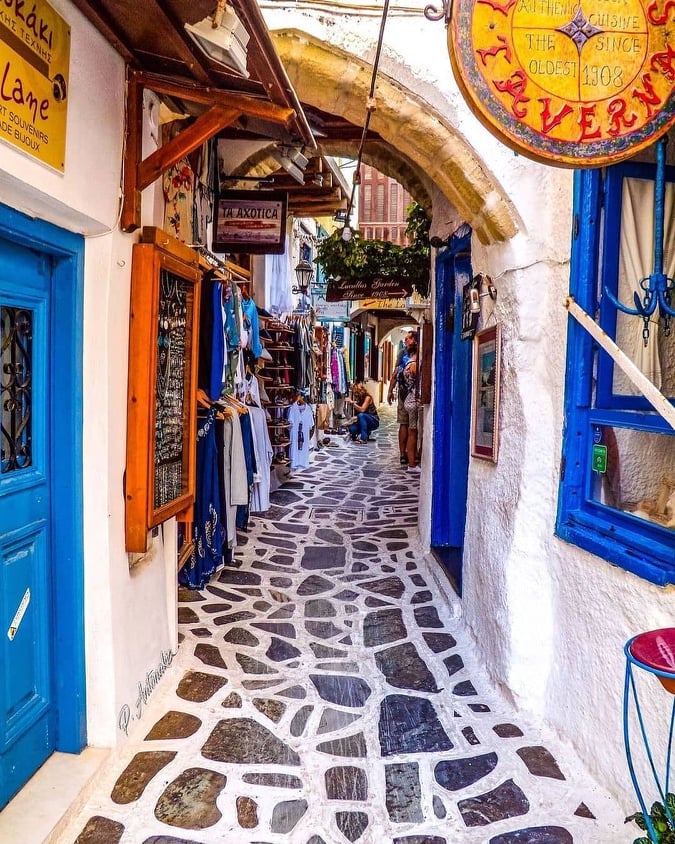
If you arrive by ferry one the first things you will see is the ancient Portara, which in Greek means “big door” and the picturesque capital of Naxos beyond it. Nudge your way through the crowd disembarking from the daily ferry, traverse a boardwalk where dried octopus dangles from awnings and step into a whitewashed labyrinth of cobblestoned alleyways opening onto shops and outdoor restaurants. You’ve arrived in the main town of Naxos known as Chora (pronounced ‘hora’, it’s the Greek word for town) with influences of architecture and history covering centuries on end …
The old town has a mystifying labyrinth of cobbled alleys and courtyards. Just getting lost in the cobbled streets of the Chora can make for a good time with something interesting around every corner. There are a maze of stairways, passages and alleys to explore among the Cycladic structures, with shops selling handmade items like jewellery, works of art and replicas of prehistoric Cycladic figurines. Take a break occasionally to enjoy coffee or another beverage in one of the enticing cafes, soaking up the magical atmosphere. The old town is a hive of activity at night – don’t be too surprised to turn a corner to find an eccentric artist painting on a multicolored easel under a dim lamp light.
Just above the whitewashed buildings of the old town, take a walk through time and discover the hidden world of the Kastro (castle). It was built by Venetian Emperor, Markos Sanoudos II in 1207 as a protective shield to the fortress and was the seat of power in the Cyclades for 300 years. The most remarkable feature of the castle is its pentagonal shape. It had three gates, two of which still exist today: Paraporti, its southern gate and main entrance for visitors; the northern entrance, or renowned Trani Porta; and a southeastern gate, Piso Paraporti, which has not been saved. Passing through the surviving gates one enters a world of tranquility, narrow alleys, courtyards adorned with flowers, and old mansions with coats of arms on their lintels.
Within the castles inner walls are a number of Venetian residences, a 13th Century Catholic Cathedral, and the French School where Nikos Kazantzakis, Greece’s greatest modern writer who wrote among other things, Zorba the Greek and The Last Temptation of Christ, studied. The building is now the Archaeological Museum which contains some fine examples of white marble figurines and ceramics. The castle has been continually inhabited since it was built and during the summer hosts concerts and exhibitions which are advertised around the town on posters and brochures. The Kastro originally had several towers of which one remains, called the Glezos Tower which was restored in 1968 after being donated to the National Archaeology Ministry by its owner Petros Glezos.
The area called The Bourgos is where the Greeks lived when the Venetians controlled the town and its winding streets are full of restaurants and shops. The northern part of Naxos town is called Grotta and has a pebble beach which is not used much since the northern winds make it pretty rough and difficult for anyone but the best swimmers, body surfers and wind surfers. However when there is no wind and it is calm it can be very pleasant. There is an archaeological site here that is open to the public. The southern part of Naxos town is Agios Georgios Beach which is very popular and has a number of hotels, cafes, restaurants and bars. The harbour itself is a lively area of cafes, restaurants, travel agencies, ATM’s and shops.
It’s easy to combine history and culture with a bit of sightseeing and sunset viewing all in one free self-guided excursion just a few minutes’ walk from Naxos Town. All you have to do is take an evening stroll along the short causeway leading to the peninsula on the edge of town (an area known as the Palatia district). Climb the hillside and you’ll find yourself on one of the island’s best sunset viewing spots, right next to one of the most famous monuments on the island – the giant stone door frame known as the Portara.
FILOTI
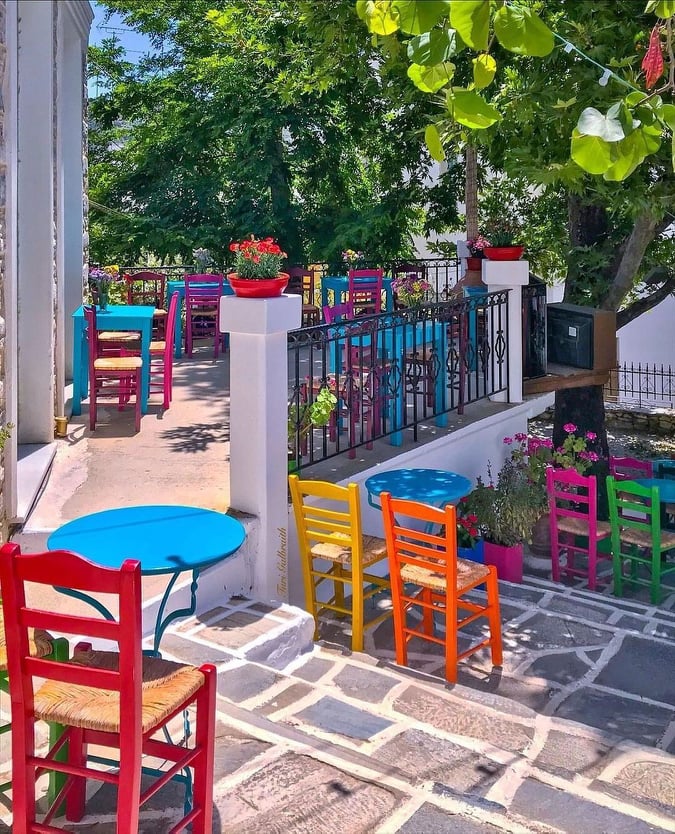
Filoti is the largest village on Naxos and after Chora has the most permanent residents on the island. The village is a perfect destination for a vacation with many choices for accommodation, restaurants, cafes and folk art shops. Interestingly, the name Filoti is believed to be of Ionian origin.
Considered one of the most beautiful villages of the island, Filoti is situated in the Tragea region and is well-known for its olive groves and little Byzantine churches. It is actually comprised of three smaller settlements Liiri, Klefaro and Rachidi, and the population totals about 1 800 which make it the largest village in numbers on Naxos.
It is a traditional Cycladic village built amphitheatrically on the slopes of mount Zas with breathtaking views of the mountains, whitewashed flat roofed houses and narrow, heavily flowered streets. The locals use their roofs as balconies or terraces during the warm summer months. The main street is the centre of village life in terms of cafés and restaurants. The little paved square named Gefyra (Greek – bridge) is surrounded by picturesque “kafenia” (Greek traditional cafes) serving ouzo and meze (snacks), and a number of taverns and retail outlets, all shadowed by a huge majestic plane tree.
Left of the square a stone-paved road leads to the village’s two neighbourhoods, Liiri and Klefaro, and the church Panagia (Virgin Mary) Filotitissa. A little further down the road the Barozzi Tower is a striking remnant of the island’s lengthy period of Venetian rule. Next to the tower a marble wall with an inset marble tap has constantly running spring water bearing an inscription dating back to King Otto (Greek – Othon) who reigned from 1832 to 1862. He was the first king imposed on modern Greece (Post Hellenic Revolution) and was of Bavarian descent. Rachidi, the village’s other main neighbourhood is uphill, south of the tower.
Cultural venues include the ancient-styled sports stadium and adjoining entertainment theatre, the war-heroes’ cenotaph and the Filoti Cultural Association Centre which houses a library, cinema and a reading club. If perchance the doors are open, Filoti has outstanding old churches all worth exploring for their frescoes. The Greek Numismatic Collection Museum of Nikolas Moustakis is worth a visit and is housed in an older well maintained building.
Interesting sights in Filoti’s surrounding area include the fountain of Arion on Zas mountain’s slope, the Zas cave where Zeus was raised, Chimarros tower on the road to Kalandos, as well as numerous Byzantine chapels with original frescoes.
The village also hosts the island’s biggest traditional festival – a three-day ‘pangiri’ starting on the 15th of August each year with dancing to the sounds of local violins, and coinciding with the Church of Panagia Filotitissa which honours the Assumption of the Virgin.
Roughly 60 000 sheep are reared in this area and Filoti is renowned for the excellent quality of its livestock products, such as lamb and goats meat’ and a wide variety of cheese products (anthotyro, arseniko, kefalotyri, myzithra and xinotyro), while a cooperative of local women produce and sell homemade sweet preserves (Greek – Glyka koutaliou). Don’t leave without sampling their delicious cuisine.
APOLLONAS
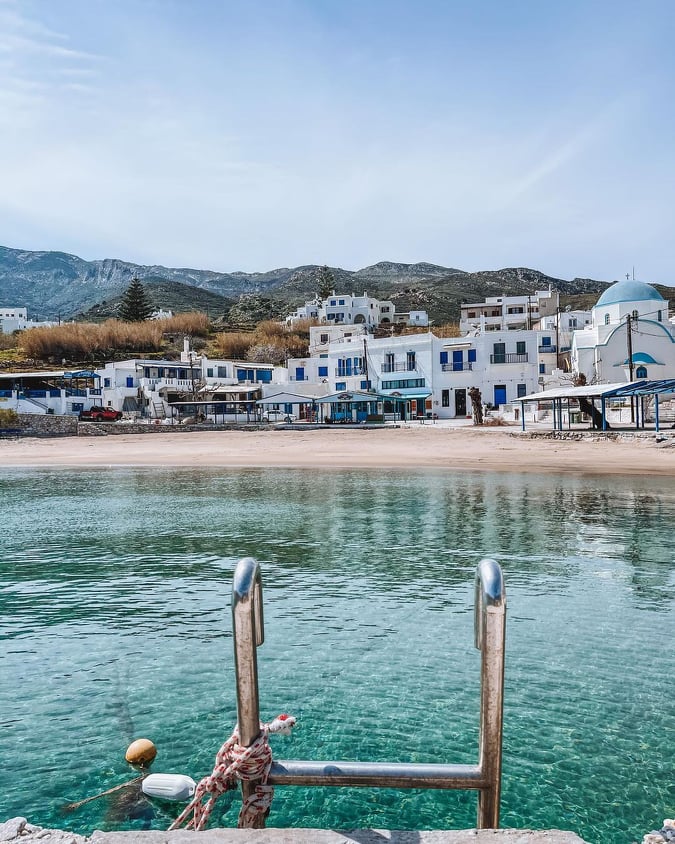
Apollonas, a quaint seaside settlement on Naxos’s northeastern coast about 36km from the island’s capital (Chora – Hora), is a charming fishing village inhabited since antiquity, probably on account of the marble quarry. In days past, it served as the port of the village of Koronida (Komiaki) from where Naxian marble was exported. Remnants of the ancient port have been found at Marmara. It is a lovely drive to Apollonas as the road snakes the entire north-west coast offering magnificent views.
In the village itself, picturesque whitewashed houses are dotted around a small sandy beach which stretches on to a larger beach strewn with smooth pebbles. The beach is lined with tavernas, cafes, souvenir shops and a mini-market. Apollonas is the ideal base for exploring the surrounding areas and there is a variety of accommodation available from rooms to let to hotels. Do book early to avoid disappointed as accommodation is limited.
An unfinished 10.5 metre statue of Kouros was discovered just a few metres outside the entrance to the village. The statue dates back to the 6th century BC and archaeologists believe it represents the god Dionysus. By following the signs to the top of the village you will see another unfinished 7 metre Kouros statue still lying there (others have been stolen). It is said that these statues were left on Naxos Island because of mistakes that occurred during their sculpting.
Towering on a hilltop above the inlet, don’t miss the ruins of the prehistoric fort atop Kalogeros.
Agios Ioannis (St. John) is the patron saint of Apollonas and is celebrated on August 29th. Vespers on the eve of the celebrations are followed by a litany procession of the icon of St. John, and then by a traditional feast, music and dance (panagiri) in the local tavernas. Visitors are welcomed with open arms.
On June 28th the village holds the annual Fisherman’s Festival when the blessing of the waters and boats takes place, followed by a joyous celebration of wine, food, music and dance.
HALKI
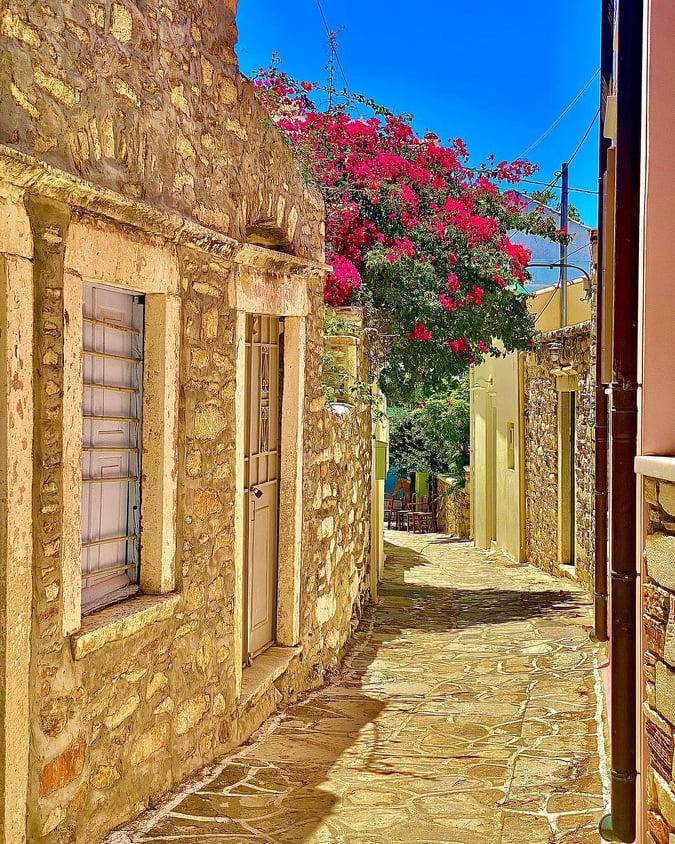
Fifteen kilometers inland from Naxos town (Chora) lies the beautiful traditional village of Halki on the plateau of Tragea with its picturesque streets and squares, flowery balconies, orchards and olive groves.
An important commercial centre of past decades due to its strategic position, Halki had substantial economic development that allowed the inhabitants to build wonderful towers and neoclassical houses. Nowadays Halki boasts a different kind of development with beautiful art galleries, boutique guesthouses, restaurants and coffee shops.
If you visit Halki, follow the paths that lead you to exquisite Byzantine churches (including the impressive church of Panagia Protothroni, Evangelismos), visit the 17th century-tower of Barozzi and do not forget to try kítro, the local Greek spirit made out of citrus tree leaves!
APEIRANTHOS
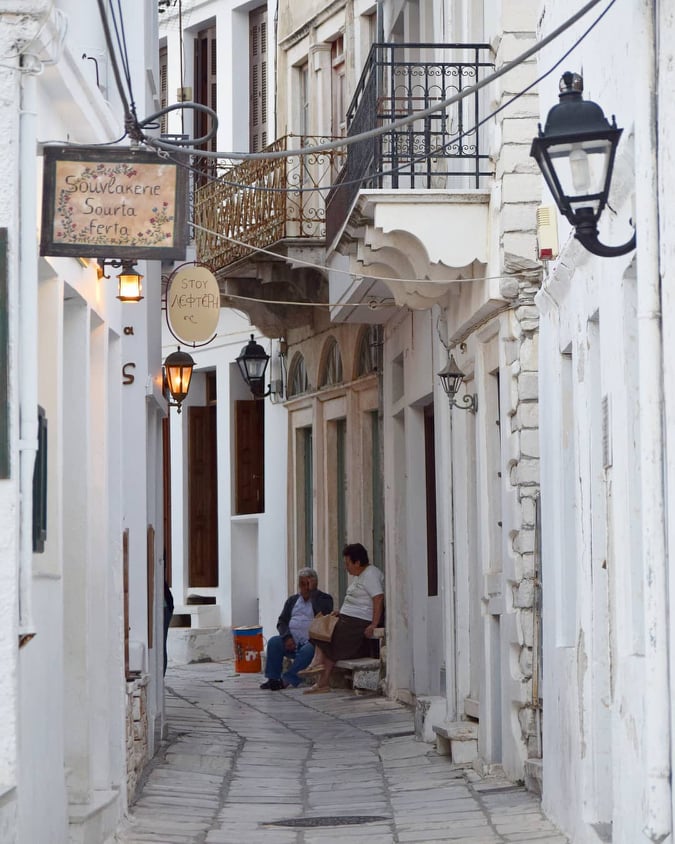
Probably the ‘most authentic’ village on the island and known as the ‘marble village’, Apeiranthos is located roughly in the centre of the island. Amphitheatrically built on the slopes of Mount Fanari, it boasts magnificent views of the Naxian mountain ranges.
This is no ordinary village, far from it. Apeiranthos has managed to retain its unique authenticity for centuries, which is apparent in every step you take, in every alley you walk and wherever you look. The particular dialect of the people of Apeiranthos alongside their unique customs suggests that most likely Cretans inhabited the region during the 10th century. This small village is where Manolis Glezos, the hero of Greek resistance and politician originates from.
Of its most impressive features is the architecture, stone built towers, old houses and churches, marble paved alleys, traditional small souvenir and local craftsmanship shops, and its 5 museums, namely:
the Apeiranthos Archaeological Museum
the Geological Museum
the Museum of Natural History
the Visual Arts Museum and
the Folklore Museum
all well worth visiting.
A visit to the Apiranthos Women’s Traditional Crafts Cooperative located opposite Panagia (Virgin Mary) church is highly recommended -if only for a glimpse of the woven products made on traditional local looms (krevataria). Continuing tradition, locals reproduce and create excellent quality woven products and other decorative items for domestic purposes. The cooperative was founded in 1987 on the initiative of then mayor Manolis Glezos –a Greek WWII resistance hero. The products, which are made in a section of the village Cultural Centre during winter, are exhibited in a showroom opposite the aforementioned church every summer for you to pick up some hand-woven textiles straight from the source. Besides woven items it also retails books by local writers.
From Chora (Naxos town) the shortest route to get to Apeiranthos is via the villages Galanado, Damalas, Damarionas and Filoti and it is 25km long.
However the most commonly used route is from Galanado to Halki and Filoti which is only 1km longer, but offers easier access and showcases the beauty of the countryside as you drive ever upwards to get to its jewel.
VIVLOS-TRIPODES
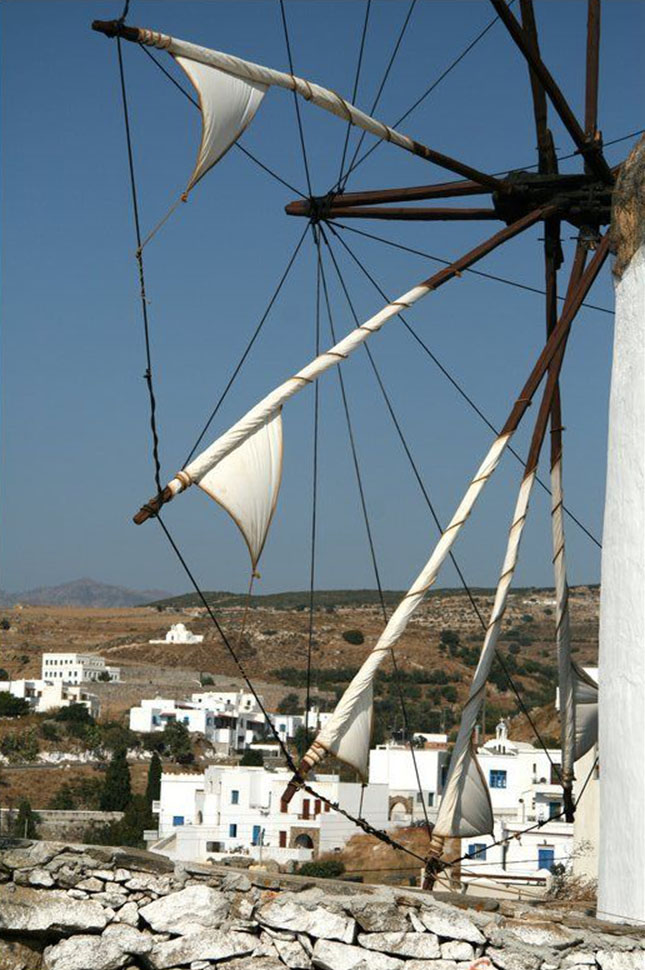
Tripodes also known as Vivlos is one of the largest and most picturesque villages in southwestern Naxos with its trademark three windmills which stand on the hill and are visible from the road that leads to the village. It is situated on the road to the south-west beaches of the island, about 8km from Chora (Naxos town) and very near the famous beach of Plaka.
Its paved streets are very narrow and are lined with whitewashed houses of authentic Cycladic architecture. Despite its double name, all village signs refer to the village only as Vivlos. The village has more than 800 permanent residents and is one of Naxos’s most vibrant villages.
To the west are the remains of the tower of Ai Giorgis (Agios Georgios – St. George), which is built on a precipice. The ruins of Plaka Tower and the chapel of Agios Mattheos built on the ruins of an ancient temple (a common Christian practice) have led to speculation that at one time the settlement was originally built on the seaside area of Plaka.
The list of sights to visit in and around the village include the church of Panagia Tripodiotissa (the village’s patron saint), a number of traditional windmills which are in need of repair, the Plaka Tower known locally as Paleopyrgos (Greek – Old tower) or also known as Ariadne’s Tower at the entrance to the village, and finally the Folklore Museum which is housed in a restored olive mill.
Nearby one can admire the wonderful Temple of Theotokou and its beautiful and very valuable hand-drawn icons. The village is known for its numerous small churches (about 40 of them) strewn over the beautiful surrounding countryside, its historical background, its archaeological monuments and the friendliness and warm hospitality of its inhabitants.
Tripodes (Vivlos) has prospered thanks to the plain of Plaka which provides agricultural products of good quality. Among these are the nationally sought after Naxos potatoes, fruit, vegetables and grains. Vines are also cultivated which produce some very good wine.
Several kafeneia (traditional Greek cafés) and traditional tavernas are found around the village square with large eucalyptus trees offering shade and cool rustling in the breeze. A joyous celebration for Panagia (Virgin Mary) is held on August 23, and the festivities attract people from all over the island.
DAMARIONAS
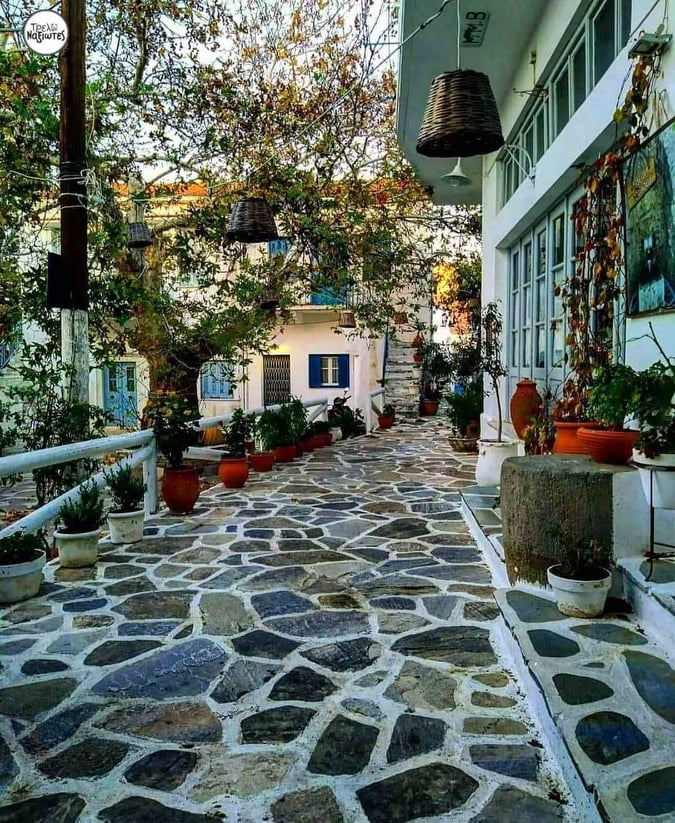
Damarionas is a classic Aegean village in the centre of the island. The village is considered a mountainous one although it is only at an altitude of 230 meters. It is a beautiful settlement built on the south side of the sunny Tragea valley.
The village apparently acquired its name from Damaris the Athenian who was amongst the very first to accept Christianity and passed it on to the settlement who honoured her by naming the village after her.
It is said that the first inhabitants of Damarionas actually inhabited the coastal area of Agiassos, but the prevalent fear of pirates forced them to migrate inland.
Today Damarionas, with its picturesque white-washed houses adorned with flower pots and flowers, paved streets, genuine Cycladic churches and beautiful squares has been listed as a traditional settlement and offers many attracions such as the mansions’ “Prompona”, “Vasilikoulas” and “Bakalainas”, the beautiful “Square of Potirou” with a huge and very old plane tree, and the old churches of Christ and St. George in the Patelou square. The “Androniki” Spiritual and Cultural Centre serves as a space for meetings and conferences. Damarionas is also home to many picturesque early Christian chapels in the greater area of Baouzi as well as the early Christian church of “Kaloritsa” built in a cave on the western side of mount Ai Lias (St. Elias – Elijah).
Locals are mainly farmers and almost everyone in the village owns an olive grove (Greek – elaiochorafa). The village operates a modern mill. While here, do try the delicious Kitron Sweet Preserve and the hortopita (foraged greens wrapped in flaky, buttery phylo pastry).
The village festival (panagiri) is celebrated on the eve and the day of August 6, on the Transfiguration of the Saviour by the church of Christ, and is followed by wine, food, song and dance.
You can reach Damarionas from Naxos Town (Chora) via Galanado and Sagri villages. The road is only 16km long.
GLINADOS
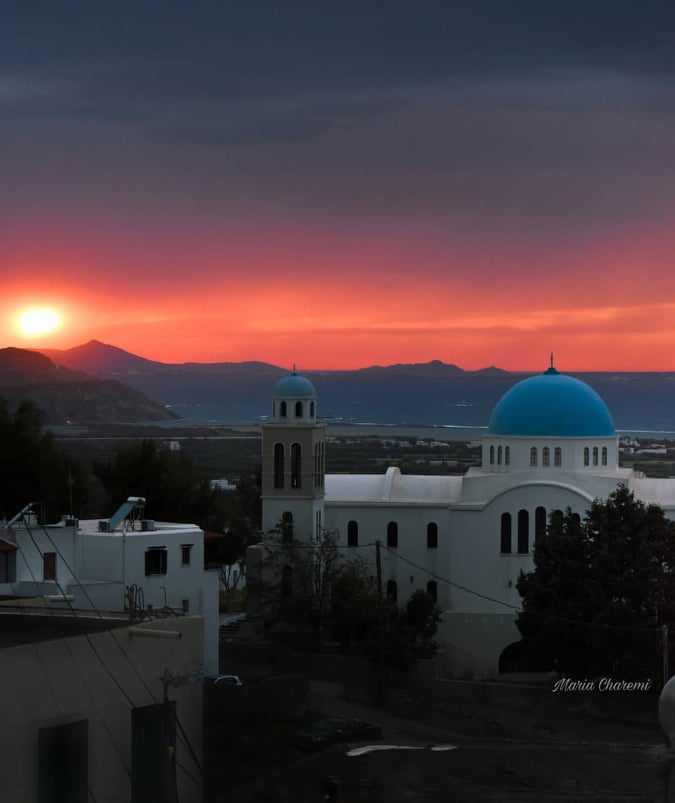
This quaint village is built on the slopes of the mountainside and is just 6 km south of Chora (Naxos town) with a population of around 500 inhabitants. The main occupation of the locals is cattle-breeding and agriculture. Glinado is a picturesque village situated near Galanado and one of the most fertile areas in Naxos. It has been called the ‘balcony of Naxos’ as it has panoramic views across green countryside all the way to the Aegean sea. The village has limited accommodation options (so book well in advance).
At the entrance of the village is the church of Agios Nikodemos, patron saint of the village. Don’t miss other attractions such as the reservoir, the mill of Kargelas, the chapel of Tzanakos and the parish church of the village “Metamorphosis tou Sotiros” built around in 1680.
Close by, in the region of Iria, visitors can see the sanctuary of Dionysus, an ancient monument dedicated to the god of wine, who lived on Naxos.
There are many churches in Glinado, which is also close to the popular beaches of Agios Prokopios and Agia Anna.
DAMALAS
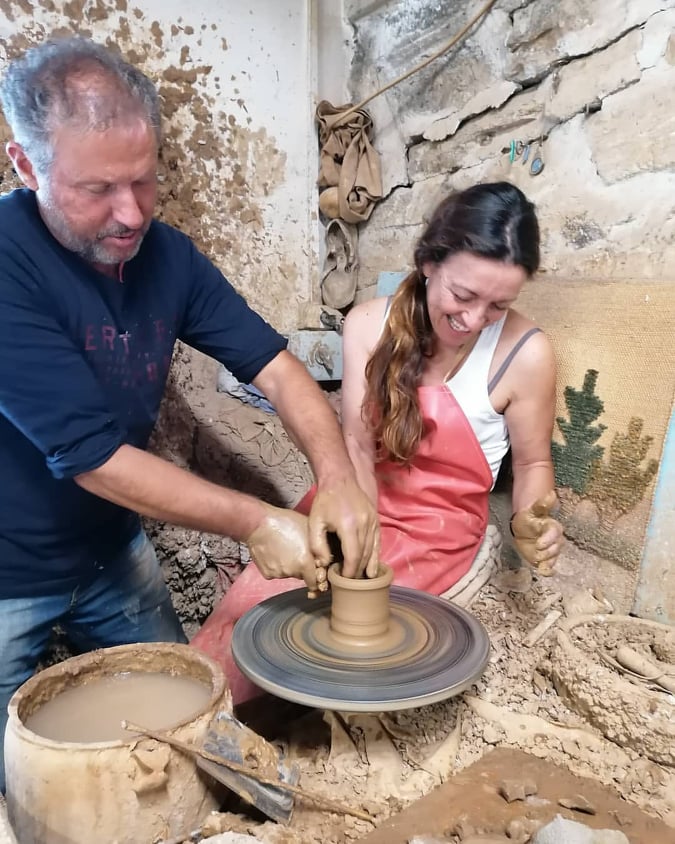
Damalas is one of the smallest villages of Naxos but has a a long tradition. It is located 14 km from Chora on the road to Tragaia at the foot of Lagos Hill or ‘the mountain of the hare’ in the valley of Tragea.
It is renowned for its old olive mill and the traditional pottery produced in the village. The olive mill started its operation around 1850 and continued to operate normally until 1960. In the year 2000 on the initiative of the Village Association it was restored and holds an annual event showcasing the traditional method of olive oil extraction. The village also has a strong tradition in pottery due to much clay in the area and visitors can try their hand at this ancient craft. The pottery workshop of Manolis Lybertas continues a centuries-old tradition.
The church of Agia Irini was built around 1800 and is beautifully and simply adorned.
A tranquil and beautiful village, the peace and quiet of Damala is disturbed only by the sounds of nature.
GALINI (Serenity)
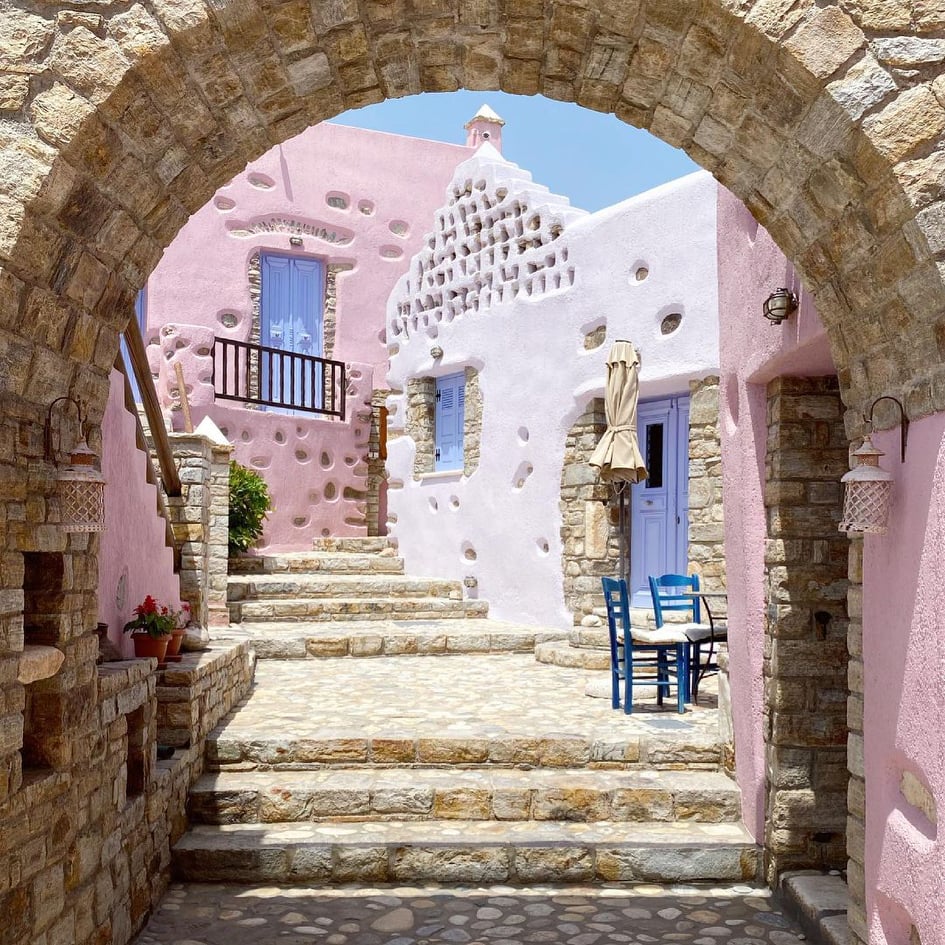
The small and beautiful village of Galini (which means serene or peaceful) is located on the Chora-Apollonas road around 6 kilometres north of Chora (Naxos Town). It sits above the fertile Plain of Eggaron overlooking vineyards and orchards, and has less than 200 inhabitants.
Just outside the village hidden in a ravine is the monastery of Ypsili. Built in 1600 BC, it served as a fortress and refuge of the inhabitants of the area during the war with the Franks.
About a kiliometre from the village at the end of the plain of Eggaron is quiet beach of Amiti. When the meltemia blow strong this beach is an ideal surfing spot.
Galini attracts many visitors because it’s tavernas serve excellent quality tradtional dishes (local meats, fresh vegetables and good quality local wine). Don’t miss a peaceful evening in one of the tavernas here for a mouthwatering experience.
KOMIAKI (Koronida)
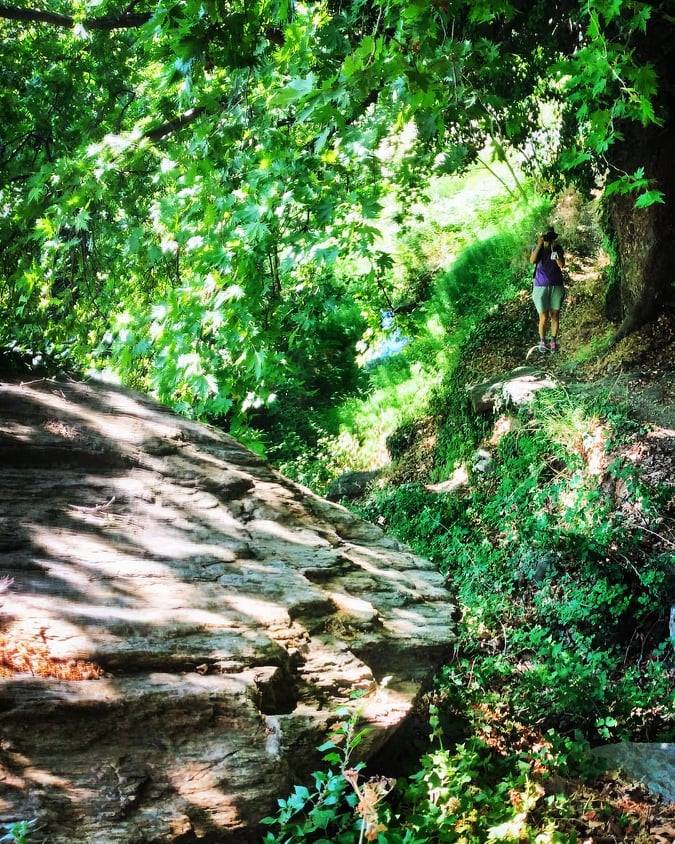
The picturesque traditional village of Komiaki (also known as Koronida) is in the north of the island at an altitude of about 700 metres. It can be reached via the villages of Apollonas or Koronos. It is said that the name Komiaki was derived from the ancient settlement of Komi, and medieval documents mention the name as far back as c.1537.
The village is 34 km from the capital Chora (Naxos Town) surrounded with fertile slopes of plane trees, oaks, olive trees, fruit trees and vineyards. Koronida (or Komiaki) is built in amphitheatric fashion on the ridge of Mt. Koronos and overlooks the Sea of Icarus (named for the myth of Icarus and Daedalus and their wax wings).
There are some 500 inhabitants in the village mostly occupied with livestock farming and agriculture. Enjoy the serenity, views and mild climate while sampling their excellent traditional dishes at one of the local tavernas. And don’t miss out on their highly-rated Komiaki wine! There is also a mini market to restock at.
A must-visit is the ancient Mycenaean domed tomb dated from 1600-1100BC (the Helladic period or bronze age) which is believed to be that of a king. It appears that village life continued uninterrupted during both the Frankish and Ottoman occupations, and there is a Frankish fort in the centre of the village.
Also in the centre of the village you will find the post-Byzantine Church of Theoskepasti and nearby, restored buildings of the watermill, the olive mill and the traditional wine press. A little further on, the existence of a Frankish castle testifies to strong feudal structures during the Frankish period.
If you are around at Easter time, enjoy the local custom of ‘The Swing’ (Greek – Kounia). Tradition has it that the boys set up the swings for girls and recite improvised poems to them as they swing them to and fro.
The parish church of the Nativity of Virgin Mary celebrates a two-day feast (panagiri) on September 8 with much food, song and dance. Visitors are welcome.
GALANADO
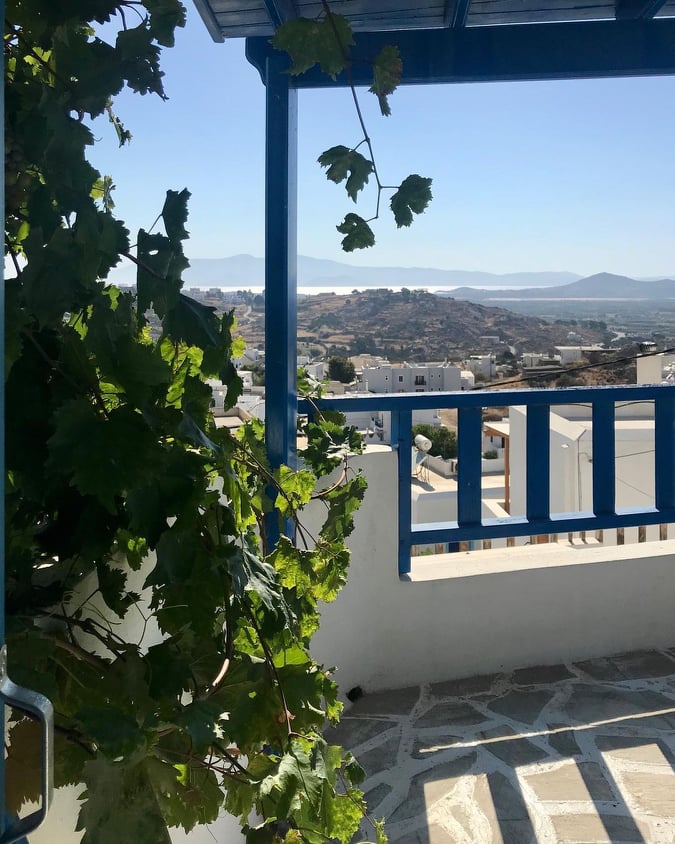
Some 5km south-east of Naxos Town (Hora or Chora), lies the picturesque village of Galanado, one of the Livadochoria. This quaint village is built on a slope in amphitheatric fashion with outstanding views of the lush valley of Livadi, Chora (Naxos town) and further beyond. The village is said to derive its name from the Latin word ‘galant’ meaning gentlemanly or courteous.
The valley of Livadi is one of the most fertile of the island, and approximately 400 inhabitants occupy themselves mainly with potato farming and animal husbandry which are the main sources of income in the area.
The local church is dedicated to the Holy Spirit and was built in 1780. On the eve of the day of the Holy Spirit, the village celebrates with a big feast (panagiri) with live traditional music, food and wine; while a solemn procession of the church’s icon takes place after mass on the day itself (It is a ‘moving celebration’ which means that the date it is celebrated differs from year to year).
To the south of the village in the greater area of Galanado you will find Belonias tower which was built c1600 by a Venetian lord. Today it is privately owned and well-maintained. Standing adjacent to the tower is the ‘twin’ chapel of Agios Ioannis (Saint John) which is rare example of separate Greek Orthodox and Catholic naves under a single roof. Catholicism was practiced by the Venetians and Franks in the area.
To the east of the village massive boulders stand upright between the churches of Agios Georgios and Agia Irini. These are thought to have been placed there by a Paleolithic settlement and are perhaps the remnants of a kind of Naxian “Stonehenge”.
EGGARES

Just a few kilometers north of Chora (Naxos town), Eggares is the richest lowland village on the island and much of what it produces accounts for a sizeable part of Naxos’s agricultural production.
This quaint farming village in the midst of a beautifully fertile plain and plentiful water springs left an indelible impression on prominent writer Nikos Kazantzakis when in his teens. The village is an array of natural beauty and colours, and it is no coincidence that Kazantzakis mentions it as an “earthly paradise” in his book ‘Report to Greco’.
Eggares has about 200 permanent residents but the population swells nearly five-fold in the summer. The hub of the village is its attractive stone-built main square next to the Church of Kimissis Theotokou (Dormition of the Virgin). You’ll also see the wonderfully restored olive mills. The first, dated 1885 now houses the municipal office and the village clinic. The second is said to be several decades older although the actual olive press is dated 1884.
Along the two streams that traverse the village are two uninhabited neighbourhoods: Messa Gitonia where the Foufopoulos tower is, and Lagada which features seven listed watermills. These are pre-industrial era structures that were in operation until the 1960’s. Just beyond Messa Gitonia lies the half-ruined church of Panagia Monastiriotissa likely built in the 9th century on the foundations of an ancient temple. The remains of some frescoes are visible.
A short distance outside the village of Eggares is a two-arched, elegant marble bridge of 1899. In the days before domestic water supply housewives would bring their clothes to wash them in the stream and light a fire under the bridge to heat the water.
East of the village is the hill of the Nativity with a small chapel built into the rock. This is where a sanctuary of the Nymphs existed in antiquity. The spot offers superb views.
Nearby is the beautiful and pristine beach of Ammitis.
The friendly hospitality of the locals is renowned and the taverns of the village serve amazing traditional dishes prepared with fresh local produce, and excellent local wine.
KORONOS
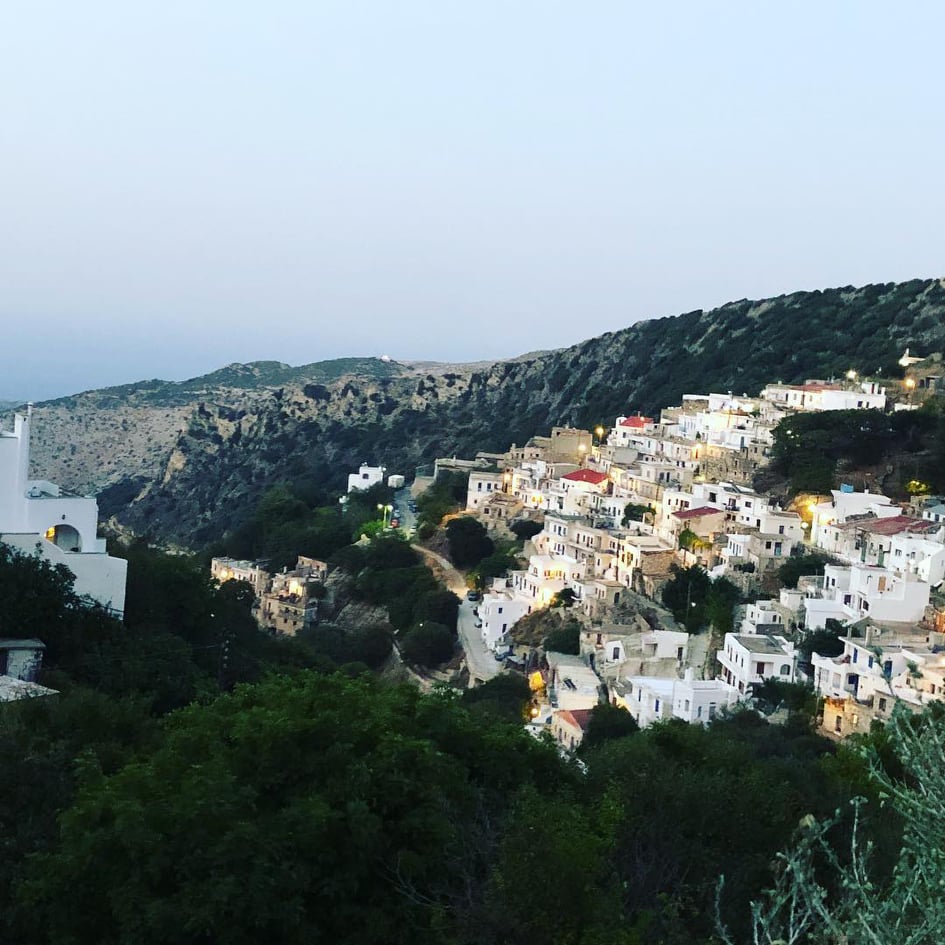
Koronos is a dramatic mountain village approximately 28 kilometers north-east of Chora (Naxos town) on the slopes of a ravine with two distinct halves facing one another between Mt. Amomaxis and Mt. Koronos, straddling an enchanting green valley full of vineyards some 540m above sea level.
The village is one of the oldest settlements on Naxos and first appears in written records c.1200 AD. It is one of the 56 municipalities into which Marco Sanudo (1153-1227), the first Venetian Duke of the island, divided Naxos.
The beauty of this village is not only its magnificent views but also the whitewashed courtyards and beautiful houses that retain the traditional island architecture, sporting wooden balconies and first-rate tavernas. A maze of stairs and picturesque alleyways connect the seven neighbourhoods, namely: Anegyrida, Kastro (Castle), Livadaki (Little field), Kato Gitonia (Lower neighbourhood), Pano Gitonia (Upper neighbourhood), Platsa (Square) and Provolakia. On one slope you will see vineyards divided by dry stone walls which provide excellent quality wine. The village also produces fine agricultural products.
Picturesque “kafenia” (traditional Greek cafes) under beautifully shady plane and poplar trees take you back in time. Almost all the aforementioned neighbourhoods have their own little central square and an old water fountain. The locals call the central square ‘Platsa’. Apart from the coffee shops and tavernas, you will find rooms to let, an eco-museum (where many events are held), a Folklore Museum (housed in a traditional guesthouse) and traditional handmade product workshops.
Before World War II, the village prospered considerably thanks to the emery mining industry. Its population then numbered about 3,000. During the German occupation the mines were forcibly shut down and a main source of income dried up, leading to death by starvation of 414 people.
By turning right about 500 metres before you get to the village, you will find the Church of Panagia Agrokiliotissa. The churches annual celebration (panagiri) takes place on the Friday after Easter Sunday with with folk music, folk dances, food and wine. Visitors are welcome to join in the festivities.
A little further out of the village at the top of Mount Koronos at an altitude of 930 metres, is the cave where Pan (assistant of the god of wine Dionysus) was worshiped. Clay statues of this deity have been excavated here.
Koronos can be reached via the island’s main road network by passing through the villages of Apollonas, Apiranthos or Kinidaros. The villages nearest to Koronos are Skado and Keramoti.
KERAMI
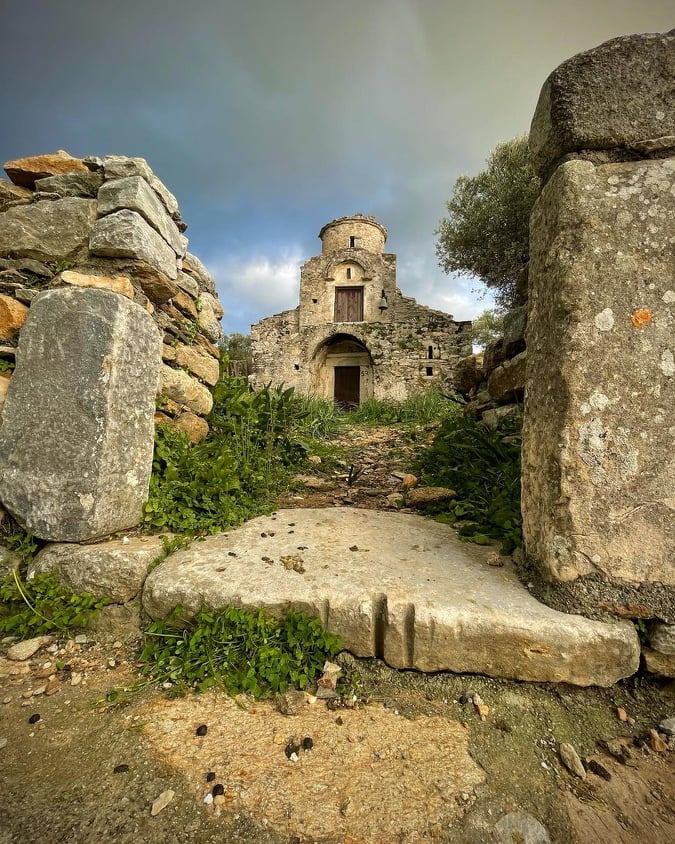
The fairy-tale village of Kerami is located in the Tragaia basin about halfway between Halki and Filoti, with its charming narrow streets, white houses, cool courtyards, lush gardens, picturesque alleyways and a beautiful views of the lush plain of many olive trees. Kerami has experienced a revival in recent years roughly doubling the number of houses and a marked presence of young people. The heart of the village beats around the church of Agios Taxiarchis where many attractive cafes and tavernas are found.
The impressive Markopolitis tower, a traditional Venetian tower in the centre of the village, now houses a modern museum well worth visiting.
Other important sights are the Byzantine churches of Agios Ioannis (13th century) – hidden amongst the olive groves next to the main road – and the architecturally rare Agii Apostoli in the nearby hamlet of Metochi, which is now abandoned but still worth visiting to see the old houses and the remains of a tower house once said to house an old Ottoman court.
After exploring the village do take a seat at one of the traditional cafes or tavernas and delight in their fresh and flavourful local cuisine.
MELANES
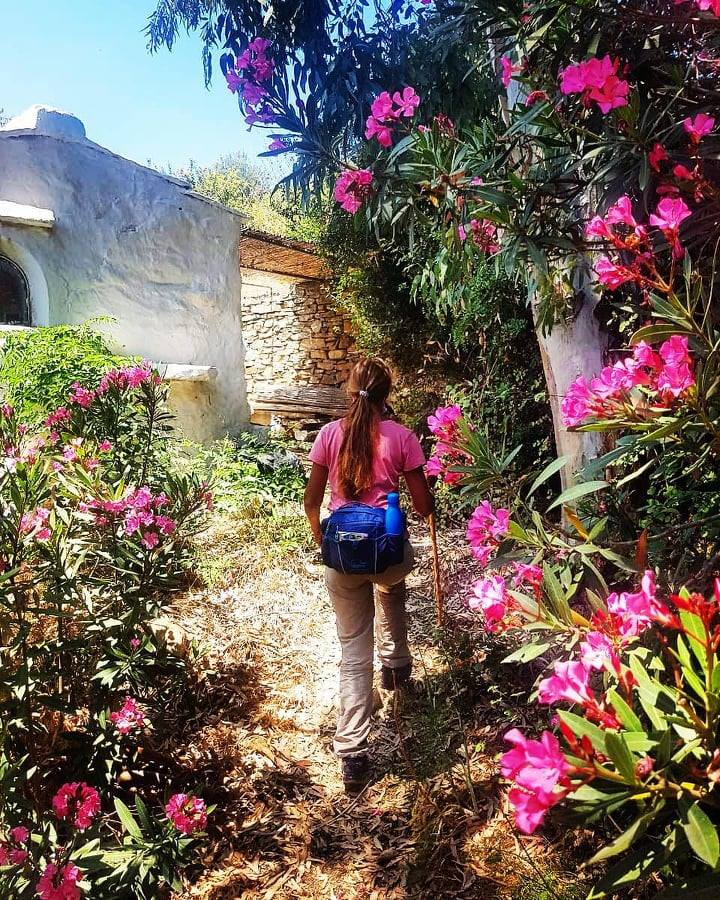
One of the oldest villages of the island, located just 8 km from the port of Naxos, Melanes is built in amphitheatric fashion on the slope of a hill overlooking a fertile valley of the same name.
According to mythology, the name of the village (which refers to the black colour) is derived from the locals’ mourning the killing of the two semi-god giant brothers Otos and Ephialtes, sons of Apollon, who were thus punished by the god Zeus for displaying arrogance. Another version insists that the name is due to the dark colour of the soil in the valley.
Melanes has around 400 permanent residents, mostly farmers, many who are renowned as skilled masons.
The church of the village is dedicated to Agii Apostoli and celebrates annually on June 29th with a big festival (panagiri) that lasts three days featuring live traditional music, dancing, local treats and wine. Visitors are welcome to join the festivities.
The greater Melanes area hosts some of the island’s most important antiquities: the entry point of the ancient Naxos aqueduct which supplied the city with water from the area, and the ancient sanctuary of the water springs was found at in Flerio. In addition, the giant abandoned statue of Kouros of the 6th century BC, lies in the ancient marble quarry a short distance outside the village.
Other sights worth seeing are the summer home of the Jesuit monks at Kalamitsia, a well-preserved medieval palace dating back to about 1680 AD, and the olive mill at Demari.
The village of Melanes has two traditional cafes and two tavernas renowned for their delicious dishes, particularly their signature dish of rooster slow-cooked in wine!
DANAKOS
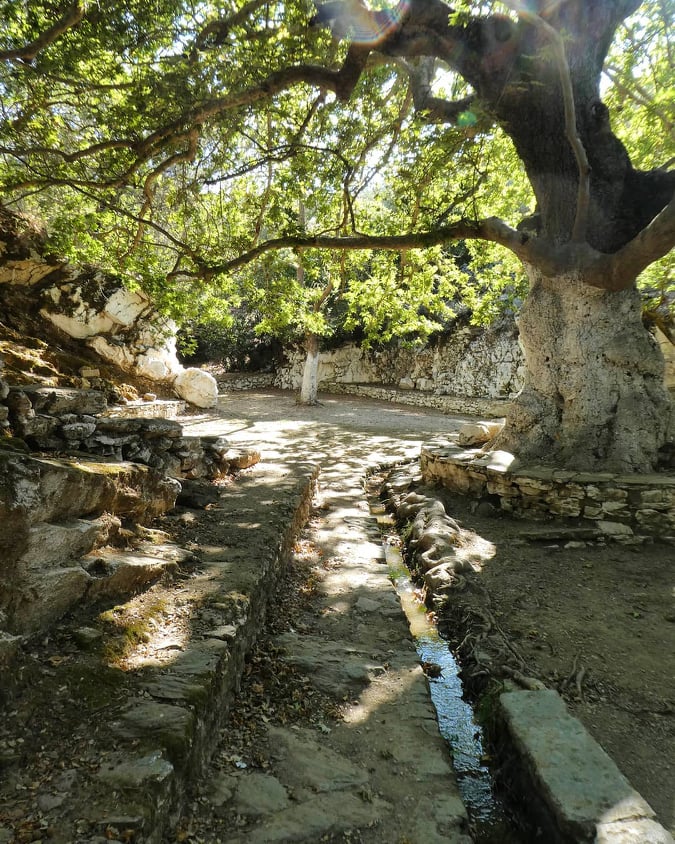
Built amphitheatrically at the foot of Mount Zas, the picturesque village of Danakos is situated deep in a gorge at the foot of Mt. Zas on Naxos’s eastern side. It is one of the island’s oldest settlements with references by Homer and ancient historians Thucydides and Polybius, but also attested by the numerous remains of an ancient cemetery, wells and Byzantine chapels in the area.
The name Danakos is thought to derive either from Danaoi –an early Greek tribe- or from “danax” – the ancient word for cane, which is considered to have proliferated in the area.
The village of Danakos is well-known for its plentiful and clear water springs which used to power a number of mills. The remnants of seven of these mills can still be seen in the lush gorge where plane trees and oleanders predominate. Its main feature is the water spring on its western side.
Cultural events, such as kouzinomagiremata (cookery contests) and concerts by well-known Greek artists are held at the plateau (central square) under the centenarian plane tree at the water spring every summer.
There are around 160 permanent residents in Danakos, the majority of whom are farmers, stone masons and millers.
Naxos’ oldest monastery, Photodotis, located at a short distance from the village, is also a must for visitors.
Zoodochos Pigi (“The Spring of Eternal Life”) is the holy patron of the village. The church is located next to the fountainhead. Vespers are held on the eve and mass in the morning on the annual Zoodochos Pigi celebration day (panagiri), which takes place on the Friday after Easter. The holy icon is then paraded around the village. Feasting, music and dance follow in the local tavernas.
AKADIMI
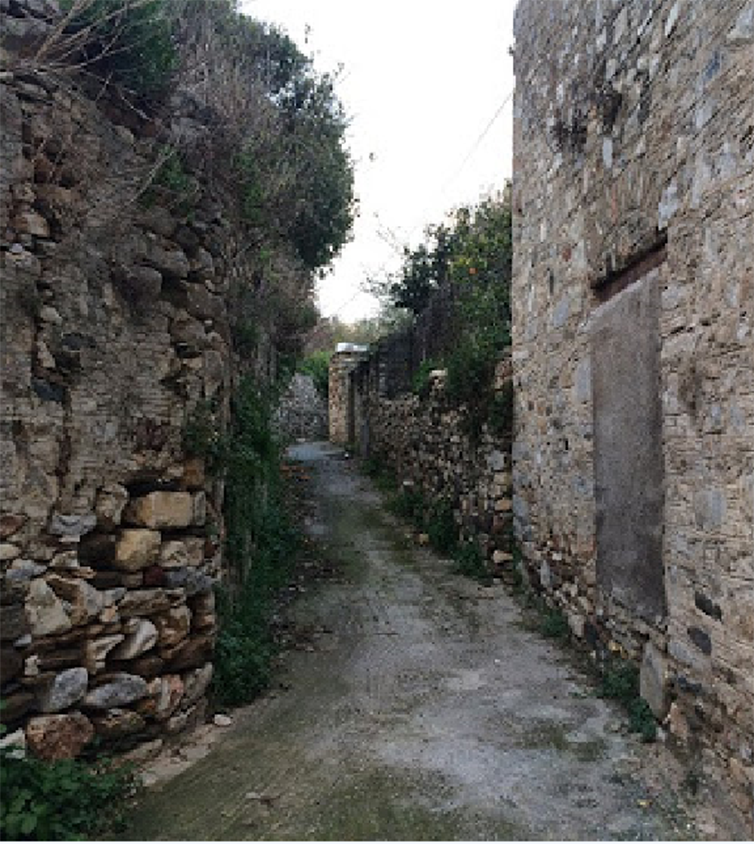
Akadimi is a small mountain village located near Halki. The village boasts the tower of Makropolitis, an impressive and imposing building which was built by an Orthodox Naxian and not by the Venetians like most other towers on the island.
The small picturesque houses of the village have large gardens and their own wells.
A handful of renowned Greeks who became famous in the domestic political scene and internationally hail from Akadimi. Among them Ioannis Papadakis, a scientist of international fame, and the MP of the Centre Union, Antonios Barotsis
The Byzantine Church of “Eisodia of Virgin Mary” is the parish church of the village and celebrates their panagiri on 21 November each year. Another church of the village is the Church of Saint Nikolaos.
There are two watermills in the village: Barotsi and Gkoufa, and a olive press.
MESSI (Mesi)

Messi or Mesi is a small quaint village in the north-eastern area of the island situated 43km from Chora (Naxos town) on the main road between Skado and Apollonas. This picturesque traditional village has approximately 100 inhabitants most of whom are emery miners.
On the way from Messi towards the village of Apollonas you find the summit of Kalogeros (Greek – monk), with it’s castle that was inhabited from antiquity to the Middle Ages. You can also see the old castle from Messi’s seaport, Agios Georgios.
Sights to visit in Messi are the renovated traditional olive oil press (called “fabrika” by the locals) and the Folk History Museum housed in the old primary school. Also visit the Byzantine church of Agia Kiriaki which dates back to the 16th century.
Do take the opportunity while visiting Messi to marvel at it’s renowned natural landmark, a centenarian plane tree (Greek – Platanos) which is next to a water spring. The spring water has been dubbed “the elixir of youth” because the inhabitants of the village are noted for their longevity. A drink from this spring and a few bottles to go may prove this legend true…
The area around this tree is also the venue of all the village’s social events. Messi holds its big religious feast (panagiri) of Agia Paraskevi on July 26th each year, and visitors are welcome to join in the fun.
In the greater region of Messi you will find the cave, Drakondospilio (dragon’s cave), and can marvel at it’s striking stalagmites and stalactites. This cave provided refuge for local people whenever pirates raided the island when piracy was rife.
Do pop in and have a bite at a local taverna; the village produces high quality wine and a variety of very tasty cheeses which are well worth sampling.
AGERSANI
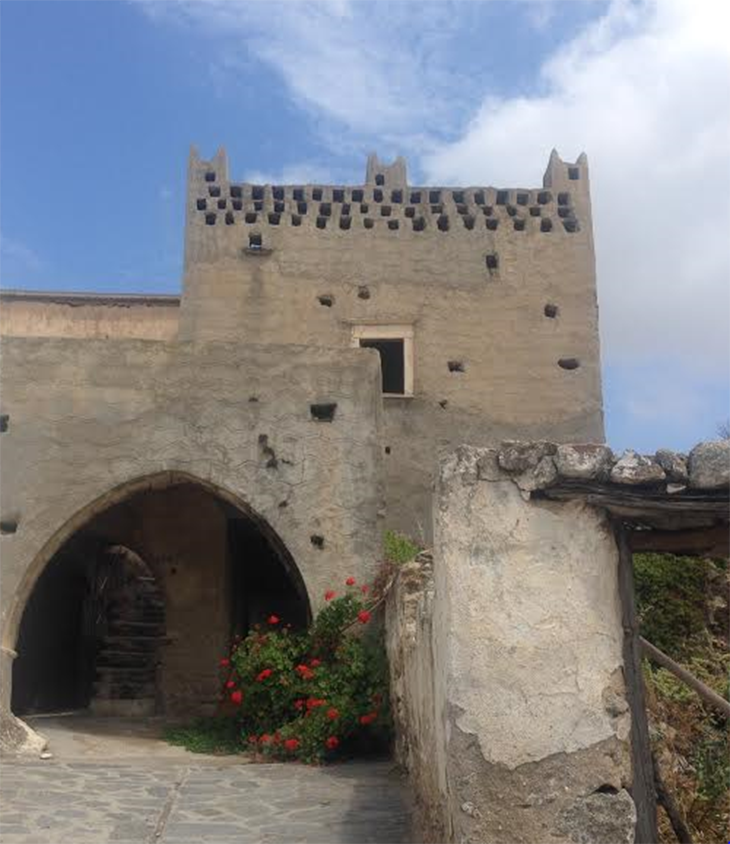
Aghios Arsenios, or Agersani as the locals call it, is a charming traditional village and one of the biggest villages on the island. It is located in the fertile valley of Livadi, eight kilometres south of Naxos town (Chora). This area is best known for the renowned Naxion potatoes grown here. Many of the locals are involved in cattle farming whose milk is used to produce the delicious Gruyère cheese made on the island.
Aghios Arsenios consists of two sections: the upper village is called Ano Aghios Arsenios, and the slightly lower lying village of Kato Aghios Arsenios. You will see many churches and chapels throughout the area.
Aghios Arsenios takes its name from the Holy One. The chapel is located just outside the village. A second church in the village worth noting is Aghios Nikolaos. In the monastery of Aghios Ioannis (John the Baptist) you can see incredible post-Byzantine icons.
Not far from Aghios Arsenios are two of the most popular beach resorts on Naxos – Agia Anna and Aghios Prokopios.
KOUROUNOHORI
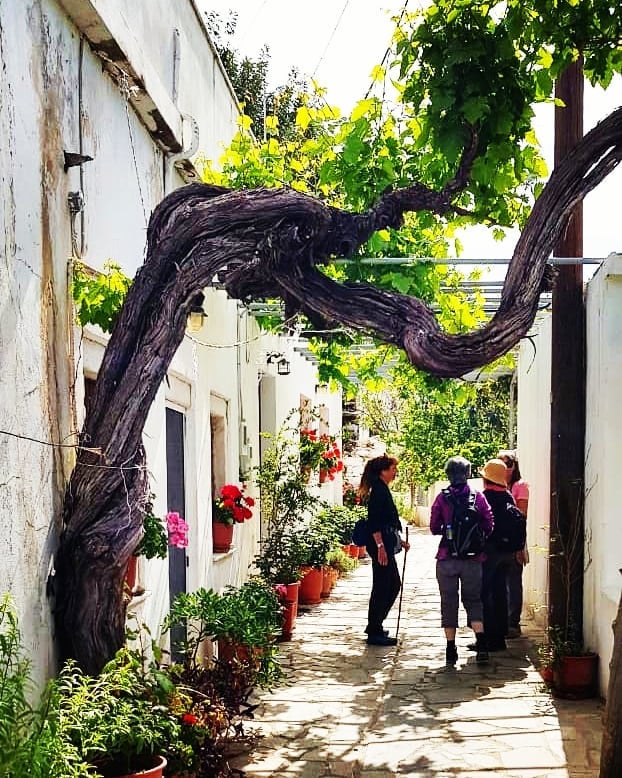
Kourounochori is a small village with a big history situated in the lowlands of Naxos in the centre of the valley of Melanes just 8 km from the town of Naxos (Chora).
A fertile area, the spring of Flerio supplies water to the whole area, and most of the inhabitants are involved in agriculture.
Archaeologically rich, there is much to see. One can admire the ancient 11 km aqueduct that was the main water supply from Fleri to Hora. It was built in the last third of the 6th century BC.
Then there are the ancient quarries that once supplied much of Ancient Greece with marble for temples and statues. Inside the ancient marble quarry, two huge kouros (statues) were discovered of 5.5 metres long each.
Also impressive is the 14th century tower of Frangopoulos which remains well preserved and habitable. The marble table in the garden of the Tower offers a historic touch to the building and bears an inscription that King Athos once sat at this table.
In the old elementary school of Kourounohori visit the small archaeological museum which houses findings from the wider region.
After soaking up the history, wander through the gorgeous alleys of the village with their whitewashed houses and blooming courtyards and enjoy some traditional cuisine at a delightful local taverna.
SAGRI
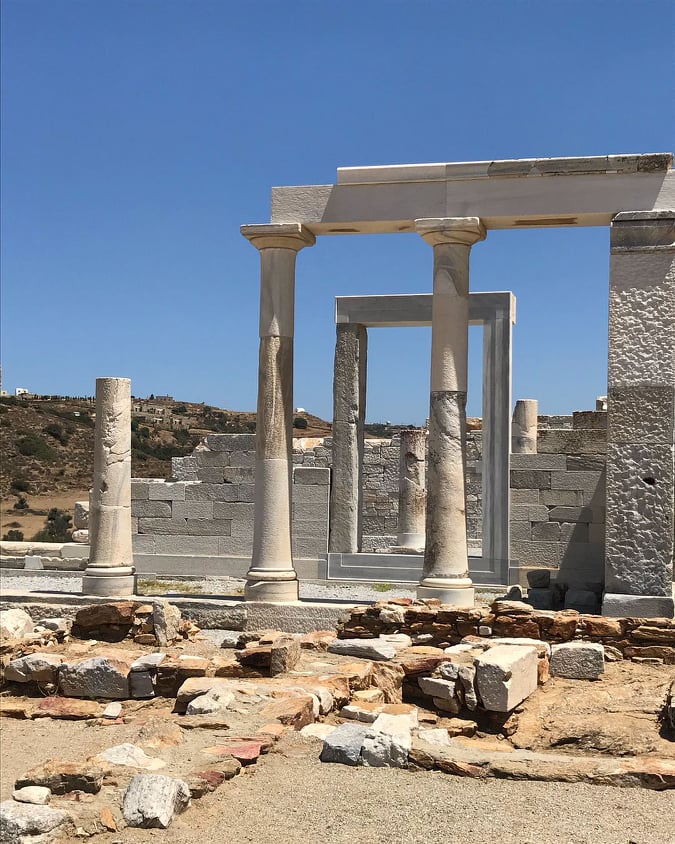
Sagri is located 10 km’s southeast of Naxos town (Chora) and comprises two settlements; Kato (Lower) and Ano Sagri (Upper) with a total of about 200 permanent residents.
Here you are stunned by strong Venetian influences on seeing it’s number Venetian towers. The atmosphere is also somewhat medieval due to many Byzantine churches, and locals call Sangri “small Mystras” because of this.
The village houses the famous monastery of Agios Eleftherios, which operated as a secret school during the Turkish occupation and today houses the Folklore Museum. Apart from this monastery, take a stroll past the Venetian towers, two of which are in ruins and one – the Palaiologos Tower – has been restored. Nearby is the tower of Bazaios.
The village is also famous for the ancient Temple of Demetra which stands about 1,5 km south of Ano Sagri. This temple is one of the most interesting archaeological monuments on the island. It is made of marble and dates back to 530 B.C.
Sagri is also known for beautiful beaches with soft white sand and wonderful turquoise sea. The most popular of these are Mikri Vigla, Orkos, Kastraki and Glyfada.
MYLI (Miloi)
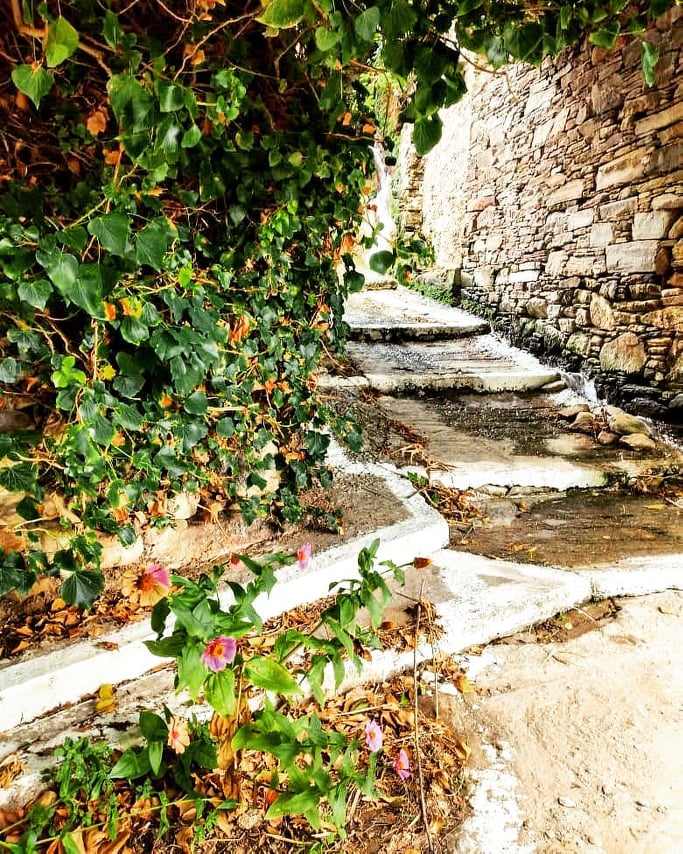
If you follow the trail from Kourounochori towards the spring of Fleri, you will come across the traditional settlement of Myli. This relatively unknown village remains pristine and unspoilt as if time stood still.
It comprises three small neighbourhoods which are connected by a stream, springs, waterfalls and old watermills. The road is lined with orchards, plane trees and olive trees. The oldest of the three neighbourhoods, Kato (Lower) Myli, has low, two-roomed houses with courtyards but most are now abandoned. Messi (Middle) Myli features just five or six double-storey houses built in the 1930’s and a whitewashed alleyway. In Pano (Upper) Myli, where most of the few remaining inhabitants live, efforts are being made to restore several houses.
Take a delightful walk through the village past ancient trees and canels running with crystal clear water. Following the water down a magical path you’ll come across a traditional cafe where you can order delicious local food and sit under the trees looking over a stunning valley.
This beautifully kept secret village will have you falling in love with it.
MOUTSOUNA
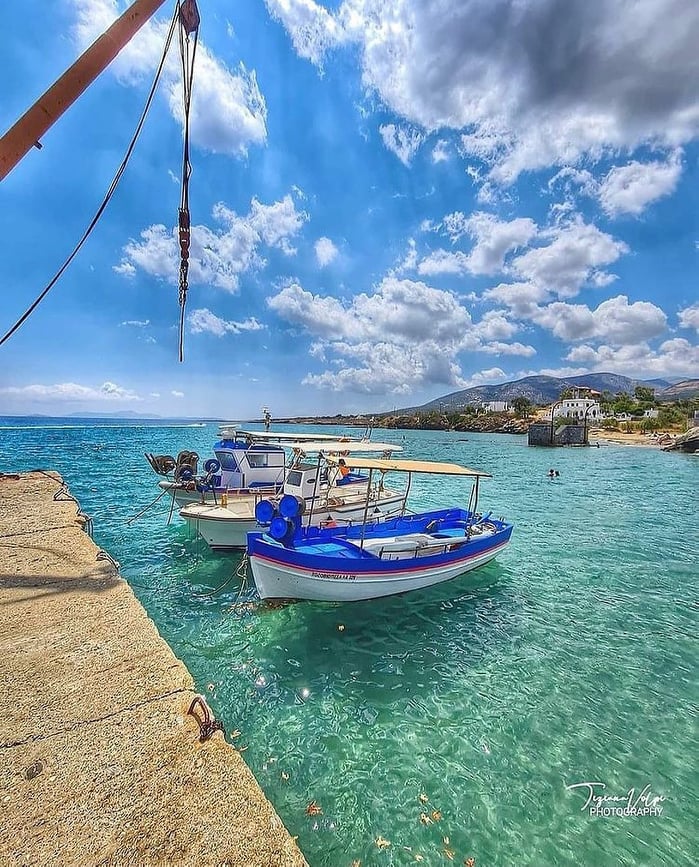
Moutsouna is a quaint fishing village on the eastern coast of the island.
Until the early 1980s, Moutsouna was the port from which the mined deposits of emery were loaded in boats and exported. The emery was mined up the mountain in Apiranthos and was transported to the port by an aerial cableway.
The cableway and the remains of the transfer station in Moutsouna can still be seen today.
In recent years Moutsouna has begun to develop as a tourist resort due to its intrinsic beauty and its coves found along the entire south-eastern coast as far as Panormos. This tranquil village has some excellent seaside taverns offering delicious Naxian cuisine.
Moutsouna is the ideal place to stay to explore the eastern island. Book early though as availability is limited.
The sights of the wider area include the old cableway, the Archaeological and Folklore Museum in Apeiranthos, two towers of the Venetian period and Byzantine chapels. Finally, south of Moutsouna, are the beaches of Psili Ammos and Klidos. These tranquil beaches are ideal for those seeking a relaxing holiday away from the crowds, and boast crystal clear waters and panoramic views of the Small Cyclades.
You will discover that Moutsouna is one of the most charming areas of Naxos.
AGIOS THALELAIOS
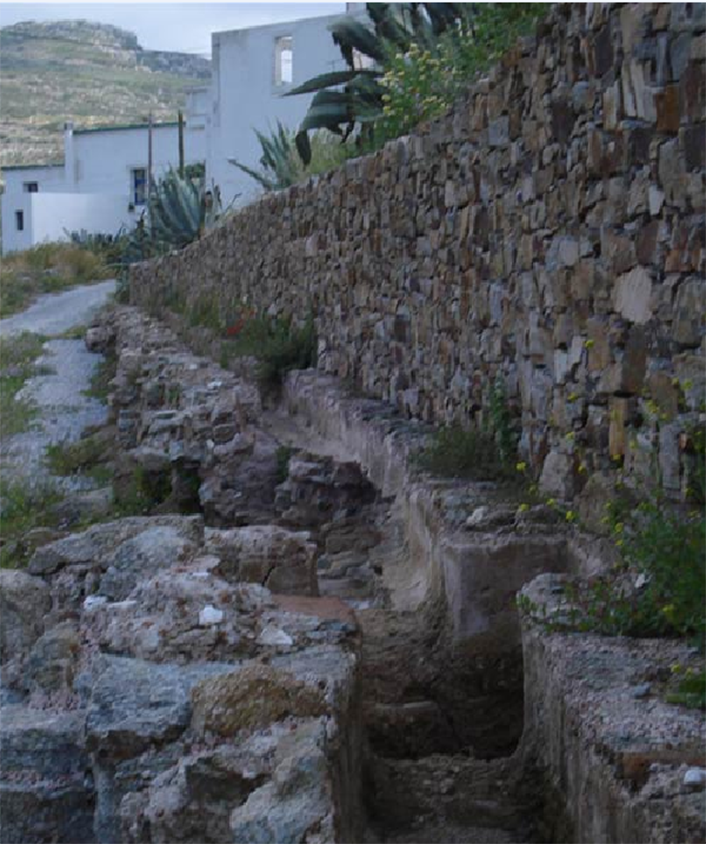
The small settlement of Agios Thaleleios is 5 km from the town of Naxos at the foot of the hill of Agios Fokas, and is one of the 4 settlements of the municipal district of Melanes.
It is a small, picturesque village with a few permanent residents. Their main occupation is agriculture and the visitor can admire the beautiful valley with orchards that stretch endlessly in front of the village.
The village took its name from the miracle-maker Saint, who healed the faithful without taking money. It celebrates on May 20, the day of a great festival (panagiri) which takes place in the courtyard of the church dedicated to his grace. Visitors are welcome.
A main attraction of the village is an ancient aqueduct that used to bring water from the spring of Flerio to Hora at the time of tyrant Lygdamis. Parts of it survive, but it has not been restored.
AGGIDIA

Just 3km from the town of Naxos (Hora) at the southwestern foot of Chrysostomos hill, is the amphitheatrically built village of Aggidia which overlooks the fertile Livadia valley below, the main town of Hora and the blue Aegean sea beyond.
The road between Hora and Aggidia road boasts many ancient and medieval monuments. These include the 14th century monastery of “to Fraro“, which played an important role in the life of the Venetians of Naxos; the ancient aqueduct of Lygdamis, a medieval water font, the ruins of the early Christian church of Agios Stefanos and low Venetian towers. There are, in fact, abundant indications that the area was a country resort for the nobility of the main town in ancient times.
A trademark of the village today is the white church of Agios Charalambos which overlooks the plain of Livadia and the endless blue of the Aegean.
Agriculture and viticulture are the main source of income for the inhabitants.
Do try their excellent locally produced wine.
VOURVOURIA

In central Naxos between 2 rivers, in a fertile valley is the picturesque village of Vourvouria.
According to one version, the name Vourvouria is derived from the word vourla -reeds that grow in abundance by the rivers. Another version suggests the village got its name from the sound of the waters that flow abundantly throughout the area.
Until 1950 Vourvouria village was attractive and prosperous, with more than 150 permanent residents, and produced significant quantities of olive oil. Today most houses are abandoned and there are no more than 25 permanent residents, but the village remains a beautiful settlement.
The alleys of the village are full of oranges, lilacs and olive trees, while many springs flow which end in the nearby river.
Take a walk through the narrow streets, light the candle in the Church of Agia Paraskevi, admire the tranquility and the sounds of nature.